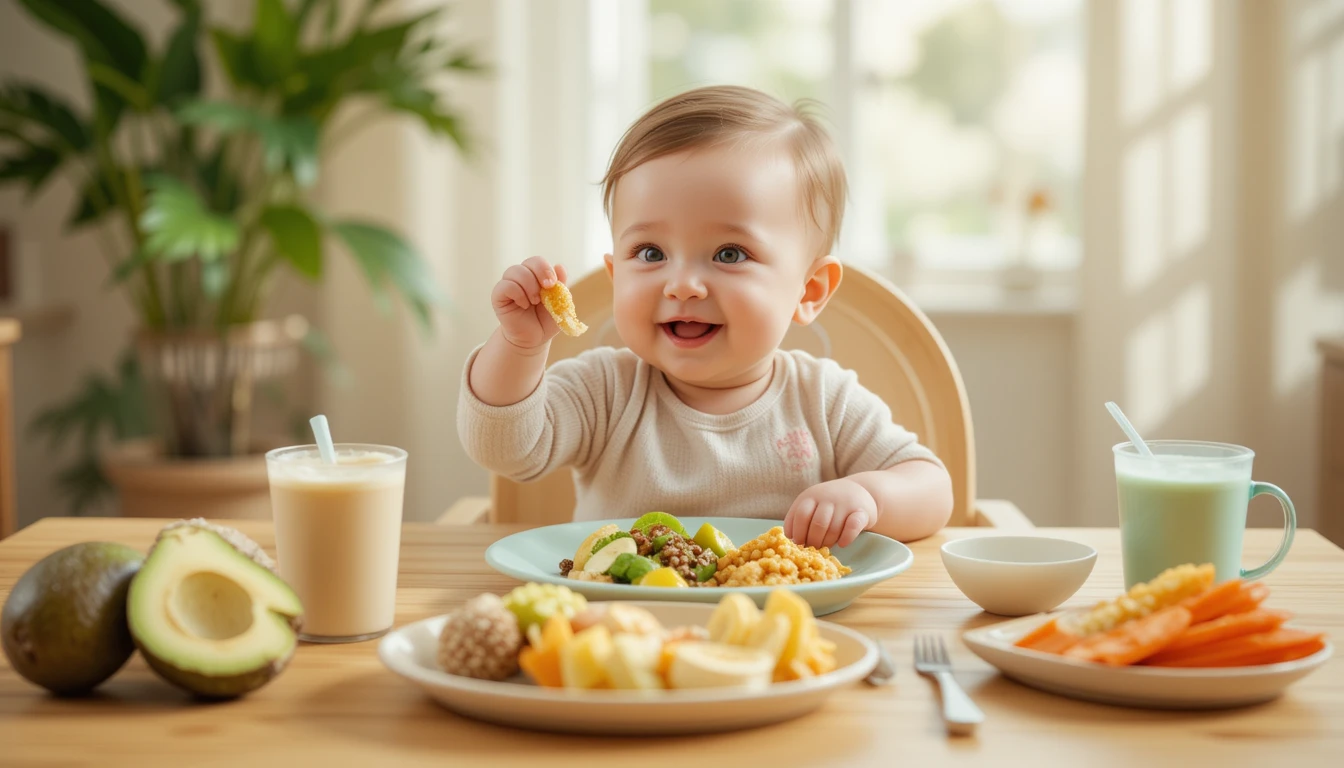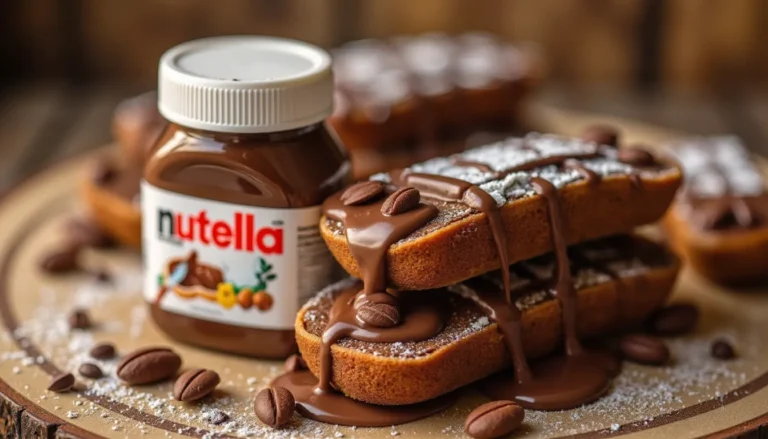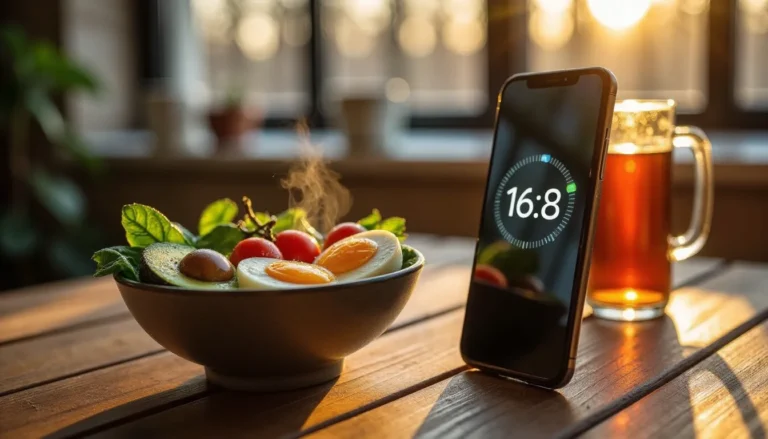Getting healthy baby lunch ideas can be both fun and challenging. As your little one grows, their food needs change. This guide offers simple lunch ideas for babies from first foods to toddler meals.
“What babies eat in their first years shapes their eating habits for life. Giving them many flavors and textures helps them learn to enjoy healthy foods.” — Dr. Maria Reynolds, Baby Nutrition Expert
Baby Food Needs by Age
What your baby needs to eat changes as they grow. Here’s a simple breakdown:
| Age | Main Nutrients | Food Texture |
|---|---|---|
| 6-8 months | Iron, protein, healthy fats | Smooth purées to soft mashes |
| 9-12 months | More varied nutrients, finger foods | Soft pieces with more texture |
| 12-24 months | Balanced meals, family foods | Table food in small, safe pieces |
Lunch Ideas for 6-8 Month Babies
When starting solid foods, focus on simple, healthy first foods. Remember that breast milk or formula is still their main food.
1. Iron-Rich Veggie Mix
- 2 tablespoons spinach purée
- 2 tablespoons sweet potato purée
- 1 teaspoon olive oil
Why it’s good: Babies need iron at this age because the iron they got from birth starts to run out around 6 months.
2. Lentil and Apple Blend
- 3 tablespoons mashed red lentils
- 2 tablespoons applesauce
- Small pinch of mild cumin
Why it’s good: Giving babies different protein foods early helps them grow well.
3. Avocado and Banana Mash
- ¼ ripe avocado, mashed
- ¼ ripe banana, mashed
- Few drops of lemon juice to prevent browning
Why it’s good: This mix gives healthy fats for brain growth and natural sweetness that babies like.
4. Colorful Veggie Mix
- 2 tablespoons carrot purée
- 2 tablespoons pea purée
- 1 tablespoon plain whole-milk yogurt
Why it’s good: This colorful mix helps babies try different veggie flavors.
5. Iron-Boosted Fruit Mix
- 2 tablespoons iron-rich baby cereal
- 2 tablespoons pear purée
- 1 teaspoon ground flaxseed
Why it’s good: Iron-rich cereals help prevent iron shortage in babies.
“Not getting enough iron as a baby can affect brain growth even years later. I suggest iron-rich foods like fortified cereals, meat purées, and beans from the start of solid foods.” — Dr. James Chen, Pediatrician
Lunch Ideas for 9-12 Month Babies
As babies learn to pick up food and feed themselves, give them more textures and finger foods. Make sure pieces are soft and small enough to be safe.
6. Mini Chicken Meatballs with Veggies
- 1 small chicken meatball (made with ground chicken, shredded zucchini, and bread crumbs)
- Small pieces of soft steamed carrot
- Thin slices of ripe pear
Why it’s good: Letting babies feed themselves helps them develop hand skills and learn to control how much they eat.
7. Cheesy Veggie Quinoa
- 3 tablespoons cooked quinoa
- 2 tablespoons finely chopped steamed broccoli
- 1 tablespoon grated mild cheese
Why it’s good: Quinoa is great for babies because it has complete protein and iron.
8. Cottage Cheese and Fruit Bowl
- 3 tablespoons cottage cheese
- 2 tablespoons soft diced peaches
- Sprinkle of cinnamon
Why it’s good: Cottage cheese gives calcium and protein while letting babies try a new texture.
9. Mini Veggie Egg Fingers
- 1 egg beaten with 1 tablespoon milk, mixed with finely diced cooked veggies, baked and cut into strips
- Soft avocado slices
- Small pieces of toast
Why it’s good: Giving eggs before 12 months may help lower the chance of egg allergies while providing good protein.
10. Sweet Potato and Apple Bites
- Small cubes of baked sweet potato
- Soft cooked apple pieces
- Light sprinkle of cinnamon
Why it’s good: This mix gives vitamins, fiber, and natural sweetness with different textures that help babies learn to chew.
Lunch Ideas for 12-18 Month Babies
At this age, most babies can join family meals with some changes. Focus on balanced nutrition while letting them eat by themselves.
11. Mini Pita Pocket
- ¼ small whole wheat pita
- 1 tablespoon hummus
- 2 tablespoons finely diced cucumber
Why it’s good: Starting whole grains early helps heart health later in life.
12. Take-Apart Sandwich Plate
- Small pieces of whole grain bread
- Thin slices of mild cheese
- Quarters of hard-boiled egg
- Sliced strawberries
Why it’s good: “Take-apart” meals let toddlers explore each food on its own and may help picky eaters.
13. Baby Pasta Bowl
- 3 tablespoons whole grain pasta
- 2 tablespoons tomato sauce with hidden veggies
- 1 tablespoon ricotta cheese
- Finely chopped soft-cooked spinach
Why it’s good: This balanced meal gives complex carbs, protein, and veggies in a way kids like. It’s also a great base for experimenting with 10 Best Low Calorie Pasta Options That Actually Taste Good for the whole family.
14. Tiny Veggie Quesadilla
- Small whole grain tortilla with melted cheese
- Finely chopped cooked bell peppers and spinach
- Side of mashed beans
Why it’s good: Giving babies foods with different textures and flavors from many food groups helps them like more foods as they grow.
15. Yogurt and Oat Parfait
- 3 tablespoons full-fat Greek yogurt
- 1 tablespoon rolled oats (soaked until soft)
- 1 tablespoon mashed berries
- 1 teaspoon ground flaxseed
Why it’s good: This protein-rich meal gives good bacteria for gut health, fiber for digestion, and healthy fats for brain growth. If you’re looking for more creative, nutritious ideas, check out our High Protein Sweet Snacks: Satisfy Cravings & Fuel Your Body.
Lunch Ideas for 18-24 Month Toddlers
Toddlers are getting better at feeding themselves and have stronger opinions about food. Keep meals healthy while making them fun to eat.
16. Rice and Bean Bowl
- 3 tablespoons brown rice
- 2 tablespoons well-cooked black beans
- Small pieces of avocado
- Sprinkle of mild shredded cheese
Why it’s good: This mix of plant and dairy proteins gives all the building blocks for growth.
17. Sweet Potato Toast Triangles
- Small triangles of baked sweet potato “toast”
- Thin layer of nut butter or seed butter
- Thinly sliced banana on top
Why it’s good: This creative bread alternative gives more nutrients per bite while helping independent eating.
18. Veggie Muffin Meal
- 1 small veggie-packed savory muffin (with shredded zucchini, carrot, cheese)
- Quartered cherry tomatoes (skin removed)
- Cucumber sticks
Why it’s good: Hiding veggies in baked goods helps kids eat more veggies. You can try similar tricks in 15 Delicious Healthy Movie Snacks Better Than Theater Popcorn.
19. Turkey Roll-Ups
- Small slices of oven-roasted turkey breast
- Thin spread of mashed avocado
- Rolled up and cut into bite-sized pieces
- Side of cooked peas
Why it’s good: This protein-rich lunch helps finger skills while giving iron from meat, which is easier for bodies to use than plant iron.
20. Baby Mix Bowl
- 2 tablespoons quinoa
- Small pieces of baked sweet potato
- Soft cooked green beans cut into pieces
- 1 tablespoon plain yogurt for dipping
Why it’s good: This balanced bowl shows how a complete meal works while giving many nutrients.
Creative Ideas for Picky Eaters
How food looks can make a big difference in whether kids will try it, especially around 18 months when picky eating often starts.
21. Rainbow Plate
- Red: small pieces of strawberry
- Orange: soft cooked carrot pieces
- Yellow: corn kernels (smashed for younger babies)
- Green: small pieces of avocado
- Purple: soft cooked beets
Why it’s good: Studies show that colorful food makes children more interested in trying new foods.
22. Dipping Fun Plate
- Small cubes of tofu
- Steamed broccoli florets
- Sweet potato wedges
- Small cups of hummus and yogurt for dipping
Why it’s good: Dipping makes veggies more fun for young children while letting them explore with their senses.
23. Muffin Tin Meal
- Fill each cup with:
- Cheese cubes
- Blueberries (cut for younger babies)
- Shredded chicken
- Peas
- Small pieces of whole grain bread
- Thin apple slices
Why it’s good: This keeps foods from touching, which helps kids who don’t like mixed foods, while still giving balanced nutrition. Also try packing some 20 Healthy Travel Snacks to Keep You Energized on the Go for variety when you’re out.
Lunch Ideas for Daycare or Travel
When packing lunches for daycare or on-the-go, choose foods that stay fresh, are easy to carry, and don’t need much reheating.
24. Divided Container Special
- Section 1: small cubes of cheese
- Section 2: quartered blueberries and strawberries
- Section 3: small pieces of whole grain bread
- Section 4: shredded chicken or tofu cubes
Why it’s good: This balanced meal includes all food groups while looking nice.
25. Veggie Muffins
- Homemade mini muffins with:
- Shredded zucchini and carrot
- Cheese
- Eggs
- Whole grain flour
- Side of fruit sauce for dipping
Why it’s good: These healthy, easy-to-pack muffins give protein, veggies, and whole grains all in one. They’re also a great complement to ideas from our 25 School Lunch Ideas Your Kids Will Actually Love.
26. Cold Pasta Salad
- Small whole grain pasta shapes
- Finely diced soft-cooked veggies
- Small pieces of cheese
- Mild olive oil dressing
Why it’s good: This meal is good cold, includes many food groups, and gives energy that lasts.
27. Yogurt and Fruit Cup
- Container of full-fat yogurt
- Small container of soft fruit pieces to mix in
- Crushed graham crackers to sprinkle on top (for older babies)
Why it’s good: This calcium-rich meal gives good bacteria and can be mixed just before eating.
28. Breakfast for Lunch
- Small whole grain pancakes
- Container of yogurt
- Soft fruit pieces
Why it’s good: Studies show that breakfast foods are often well-liked by young children and can be just as healthy as lunch foods. For nutritious morning meals, explore our 7-Day Intermittent Fasting Meal Plan for Weight Loss for parents seeking balance too.
Tips for Healthy Baby Eating
Besides lunch ideas, these basic principles are important:
29. Make Food Ahead
- Cook larger batches of basic foods (roasted veggies, grains, proteins)
- Freeze in baby-sized portions
- Mix and match during the week
Why it’s good: Planning meals ahead makes for healthier eating and less stress at mealtimes.
30. Adapt Family Meals
- Change family meals for baby by:
- Setting aside portions before adding salt or strong spices
- Cutting into safe sizes
- Changing textures as needed
Why it’s good: Babies who eat adapted family meals are more likely to enjoy more foods as they grow. If you follow a specific diet like keto, our guide on the Mediterranean Keto Diet: Combining 2 Powerful Eating Plans can help you prepare baby-friendly versions.
“The best way to feed babies respects their growing independence while giving structure and healthy choices. Parents decide what, when, and where to feed; children decide how much and whether to eat.” — Sarah Jenkins, Baby Nutrition Specialist
Important Safety Tips
Baby doctors recommend these safety rules:
- Always watch babies during meals
- Make sure food is soft enough to squish between your fingers
- Cut round foods like grapes, cherry tomatoes, and blueberries into quarters
- Avoid hard foods that can’t be made soft enough
- Introduce common allergy foods one at a time and watch for reactions
For more detailed safety information, the World Health Organization’s guidelines on infant and young child feeding provide comprehensive advice from healthcare professionals.
Changing for Allergies and Special Diets
For babies with allergies or special diet needs, talk to a doctor or dietitian for personal advice. Most lunch ideas can be changed by:
- Using plant proteins instead of animal proteins
- Using gluten-free grains instead of wheat
- Replacing dairy with safe alternatives made for babies
- Finding other fat sources if nut allergies are present
The American Academy of Allergy, Asthma & Immunology offers expert guidance on introducing potentially allergenic foods to infants.
Conclusion
Making healthy lunches for your baby doesn’t have to be hard or time-consuming. By focusing on whole foods, right textures, and balanced nutrition, you can help your little one grow well while building good eating habits for life.
Remember that each baby is unique in what they like and how they develop. Some may be ready for more textures earlier, while others need more time to like new flavors. Follow your baby’s cues while gently encouraging them to try new foods.
“The goal isn’t perfect nutrition at every meal, but building good eating habits over time. Remember that you’re teaching not just what to eat, but how to have a healthy relationship with food for life.” — Dr. Robert Williams, Child Development Doctor
This article was reviewed by Dr. Amanda Chen, Baby Doctor with special training in infant nutrition, April 2025.



Leave a Comment